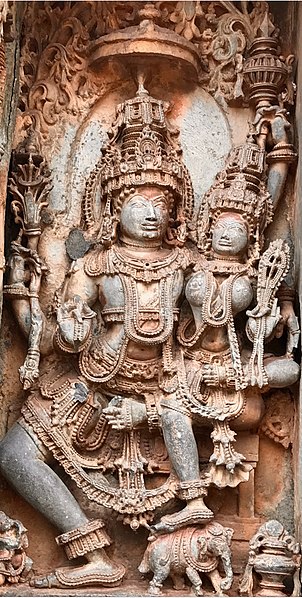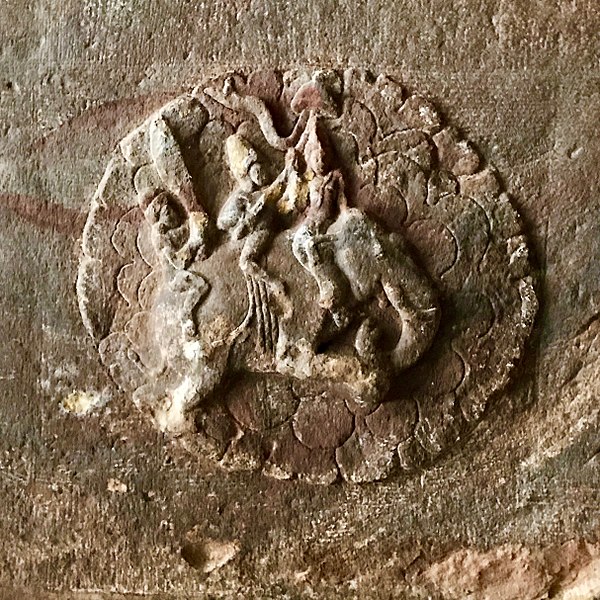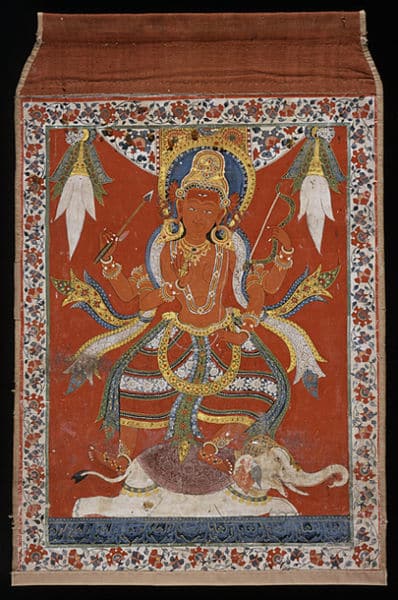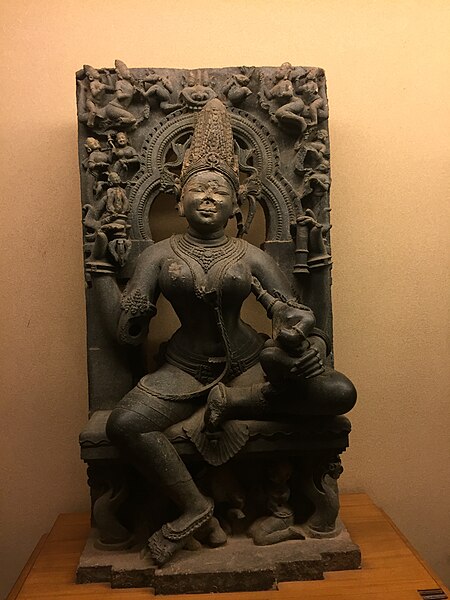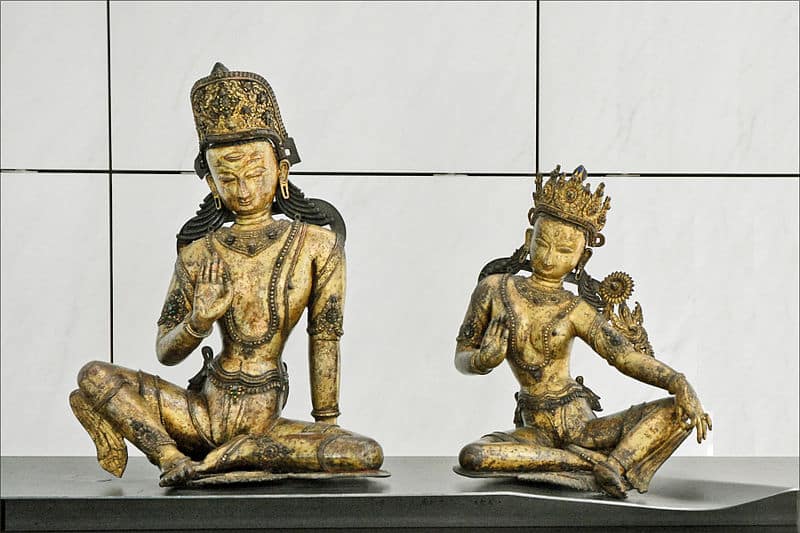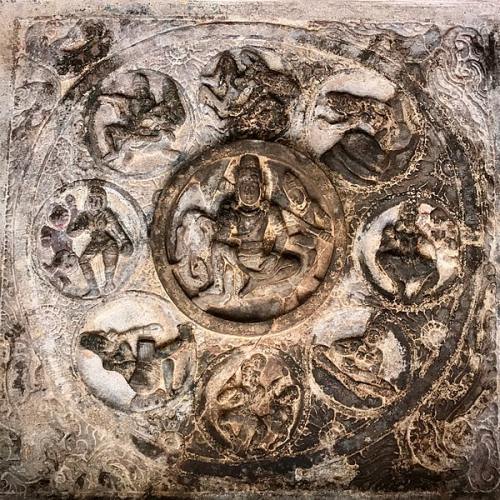Devi Indrani, the consort of Lord Indra is a uniquely positioned figure in the pantheon of Hindu Goddesses. She is a Vedic Goddess in Hinduism. But apart from Hinduism, Devi Indrani is also a revered deity in Buddhism and Jainism.
Goddess Indrani, revered as the queen of the Gods, stands as a formidable figure in Hindu mythology. Her essence, deeply woven into the fabric of divine narratives, showcases her as a deity of wrath, jealousy, and, importantly, protection. Indrani’s stories, sourced from ancient scriptures, paint her as a beacon of strength and sovereignty, embodying the complex interplay of power within the celestial hierarchy. Her role extends beyond mere mythology, serving as a symbol of fertility and devotion, guiding the faithful in their spiritual journey.
Devi Indrani is a uniquely positioned Goddess because she is the daughter of Asura ( demon ) Puloman. But due to her extraordinary beauty, purity, and virtue, Lord Indra chose her for marriage. She is also revered as one of the Sapta Matrikas, the seven divine mothers.
Goddess Indrani being born in a clan of asuras being regarded as a Goddess might be confusing to many. The general perception regarding Hinduism is that there are clear-cut boundaries between Devas ( Gods ) and Asuras ( demons). But Hindu mythology is way more complex than that and evades simplistic classification and comprehension. There are numerous examples in Hindu mythology wherein those born in the Asura clan are regarded as divine. Thus, in essence, we can say that in Hinduism, the classification of Dev and Asura is based more on one’s attributes and characteristics rather than the birth line.
Goddess Indrani is rarely worshipped as an independent deity though. She is mostly venerated with her consort Lord Indra.
Devi Indrani in the Pantheon of Hindu Goddesses
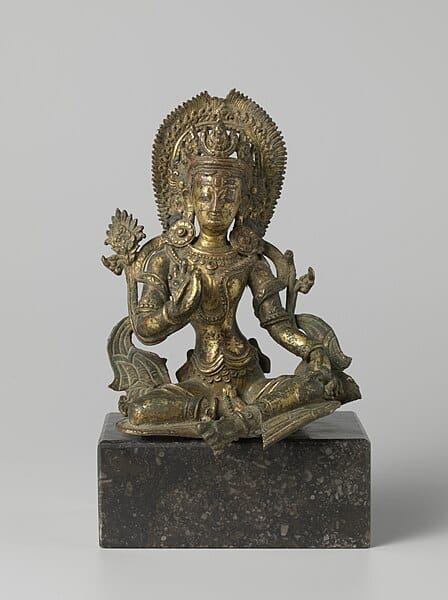
Devi Indrani is a Vedic Goddess whose name was first cited in the Rigveda, the oldest of the four Vedas in Hinduism. According to Vedic beliefs, she is the most “fortunate” woman as her husband is immortal and cannot die and cannot be touched by disease or old age.
Although Goddess Indrani has been discussed extensively in the Vedas, her role has been mostly defined in relation to her husband, Lord Indra. It is mostly against Indra’s roles and attributes that her attributes are evaluated. The Rigveda describes her as a woman who was imbued with exceptional celestial beauty and cites her rivals who were always jealous of her.
Yet another hymn of the Rigveda claims that she was proud and conceited, and her husband Lord Indra was submissive to her will. But in the same hymn, it is said that Devi Indrani requests God to get rid of Lord Indra’s rivals for his benefit. Thus, various Vedic hymns describe the dynamics of the relationship between Devi Indrani and Lord Indra. Even though the description might appear a bit confusing and contradictory, the ultimate refrain is that Devi Indrani loved Lord Indra deeply and was ready to go to any extent to protect the honor and prestige of her husband.
Devi Indrani is also described in the Puranas where she is referred to as the daughter of Asura Puloman and is referenced as Shachi. One also finds references to Goddess Indrani in the ancient Hindu epics of Ramayana and Mahabharata.
Indrani in the Vedas
The exceptional beauty of Devi Indrani has been described in detail in the Vedas. Because of her incomparable beauty and sensuality, she was desired by many men, and the fact they could not attain her made them wrathful and jealous of her husband, Lord Indra. Similarly, many women were jealous of the exceptional beauty of Devi Indrani lamenting that they themselves could never come near her standards. Thus, that is how Devi Indrani came to be regarded as the Goddess of Jealousy and Wrath.
As with all Hindu Goddesses, her attributes are deeply symbolic and shouldn’t be taken literally. Devi Indrani being a Goddess of Jealousy and Wrath means that by worshipping her, you can get rid of these Vikars ( defects ) of human consciousness and make your consciousness pure and guilt-free.
Symbolic Significance of Devi Indrani
Devi Indrani derives her name from her husband Indra. Thus, Indrani literally means “ the wife of Indra”. The Vedas also mention her mostly in relation to Indra. However, that doesn’t mean Devi Indrani doesn’t have an independent existence of her own. Another name of Devi Indrani is Shachi. Just as she is referred to as Indrani or the wife of Indra, Lord Indra is referred to as ShachiPathi, the husband of Shachi.
Devi Indrani is the manifestation of Shakti. As an early Vedic Goddess, she was considered an epithet of Maa Durga. In that sense, just as Lord Shiva and Shakti represent the masculine and feminine embodiments of consciousness respectively, Lord Indra and Devi Indrani personify the masculine and feminine dimensions of the cosmos. Thus, Goddess Indrani is a powerful deity who blesses her devotees with prosperity, success, and wealth and helps them get rid of all vices and negativity.
Also revered as one of the seven divine mothers, Devi Indrani also symbolizes motherly attributes of nurture and protection. Just like a mother protects her children against all evil. Goddess Indrani protects her devotees against all misfortune and negativity.
Andrani and Vedic astrology
According to Hindu astrology, Devi Indrani is the ruler of the planet Venus and symbolizes the traits and characteristics of Rajas. According to Hinduism, the core attributes of people can be broadly classified into three categories, 1. Sattva, 2. Rajas and 3. Tamas. Qualities of purity and knowledge characterize Sattva. Rajas is characterized by dynamic action and passion, whereas qualities of ignorance and inertia characterize Tamas. Thus, Devi Indrani symbolizes the characteristics of Rajas, that is the worldly attributes necessary for attaining prosperity and success.
Devi Indrani’s classification as the Goddess of Jealousy and Wrath works at a symbolic level. She helps her devotees overcome their own imperfections and feelings of jealousy, hatred, ego, etc. to achieve a purer version of themselves. She guides her devotees to the path of bliss by helping them cleanse themselves of all negativity and toxicity.
Indrani’s symbolism extends far beyond her martial prowess. She embodies the protective force that guards the divine and the earthly, a testament to her role as a guardian against chaos and evil. Her association with fertility and the nurturing aspects of the divine feminine adds layers to her character, making her a complex deity who oversees the well-being of the cosmos. This duality of warrior and protector reflects the Hindu ethos of balance and harmony, illustrating the depth of Indrani’s divine responsibilities.
Devi Indrani Representation
Devi Indrani has been depicted extensively in ancient Indian art and sculptures. She is often portrayed as a woman of exceptional beauty. Goddess Indrani is depicted riding her vahana, the mighty elephant Airavata, symbolizing dignity and power. Devi Indrani is often portrayed with a golden complex, clad in blue or red attire.
In some of the depictions, Devi Indrani is also portrayed having a red complexion with 4 hands and 3 eyes. It’s her portrayal as Matrika, one of the seven divine mothers of Hinduism. She is often depicted cradling a child in her lap, the imagery symbolizing her maternal and nurturing instinct.
Two of her hands are depicted holding the vajra and the flag. Sometimes, she can be seen holding the trident and the damaru. Her other two hands are shown in Varada and Abhaya Mudra. Devi Indrani is depicted wearing a prominent crown and numerous ornaments including the waistband. In some depictions, she is also shown sitting below a Kalpaka tree.
The artistic and scriptural representations of Indrani are as diverse as her attributes. Often depicted riding her vahana, the mighty elephant, she symbolizes dignity and power. Artworks and scriptures portray her wielding the vajra, a thunderbolt, signifying her combat-ready nature and her role in the cosmic battles. These depictions are not merely artistic choices but are imbued with deep symbolic meanings, reflecting her multifaceted roles within Hindu tradition.
Devi Indrani’s Attributes and Powers
Devi Indrani’s divine attributes are a mirror to her complex nature. Her powers, ranging from the ability to influence weather to her invincibility in battle, highlight her as a deity of immense strength and capability. These attributes are not just testaments to her might but also serve as symbolic representations of her protective and nurturing roles. The vajra, her weapon, is not only an instrument of war but also a symbol of the ultimate reality and power, further emphasizing her significance in the pantheon of Hindu Goddesses.
Other Names of Devi Indrani
Devi Indrani is also known by names such as Shachi, Mahendra, Aindri, Pulomaja, and Poulomi. In the multidimensional pantheon of Hindu Goddesses, Devi Indrani also occupies an important position as one of the Saptamatrikas. In Hindu mythology, the Saptamatrikas personify the various negative qualities of an individual like jealousy, pride, envy, wrath, covetousness, etc. By worshiping the sapamatrikas or seven divine mothers, an individual can get rid of all the negative attributes blocking the path of bliss and salvation. Thus, Devi Indrani as one of the Saptamatrikas, represents Jealousy and Wrath.
Devi Indrani Origins & Mythological Tales and Legends
According to various Hindu scriptures, Devi Indrani is the daughter of Asura Puloman who is the son of sage Kashyapa and his wife Danu. She got married to Lord Indra and thus became the Queen of the Gods. Devi Indrani has three sons with Lord Indra – Jayanta, Rishabh, and Midhusa, along with one daughter Jayanti.
There are many other stories regarding Devi Indrani’s origins. According to another version, Lord Indra created his female self Indrani to protect Devi Parvati from the lustful Andhakasura. Legend has it that Devi Indrani along with the other saptamatrikas ( 7 divine mothers ) helped Lord Shiva defeat Andhakasura and thus protect Devi Parvati’s honor.
According to another story, all the seven matrikas including Goddess Indrani emerged from different parts of Mother Goddess Shakti and helped her in defeating the powerful asura Raktabeeja.
Devi Indrani is also mentioned in sacred texts of Jainism where she is described as the mirror image of Lord Indra. According to Jain beliefs, Lord Indra and Devi Indrani are the epitome of the ideal couple. It is believed that Lord Indra and Devi Indrani descended to earth to celebrate the birth of the Tirthankaras ( supreme spiritual leaders of Jainism).
Although there are multiple mythological stories regarding Devi Indrani’s origins ( as discussed above), the most widely accepted one is that of Indrani being the daughter of Asura Puloman who was killed by her future husband Lord Indra.
Legend of Lord Indra killing Devi Indrani’s father Asra Puloman
Lord Indra and Devi Indrani’s marriage was not without its share of controversies. In fact, Lord Indra is one such God in Hindu mythology who often gets into troublesome situations and gets defeated by asuras despite being a Dev ( God). This, according to Hindu scriptures can be attributed to his fickle nature and certain negative attributes like anger and jealousy.
Legend has it that Lord Indra was smitten by Devi Indrani’s beauty and sensuality so much that she pursued her relentlessly and literally demanded that they be lovers before marriage. According to legend, they had a secret rendezvous before their marriage, and thus, Devi Indrani’s father Asura Puloman was furious at Lord Indra.
Thus, Asura Puloman comforted Indra and Lord Indra used all his might and killed him in a fit of rage. Legend has it that when Asura Puloman learned about his daughter’s secret affair with Lord Indra, he was about to curse Indra who then killed him to escape the curse. According to some versions of the myth, Indra abducted Devi Indrani after killing her father and married her.
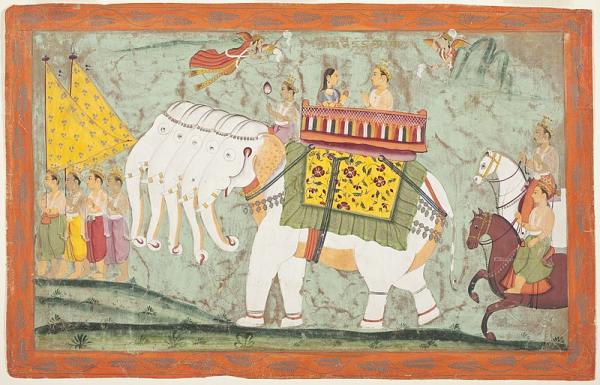
However, Devi Indrani loved Lord Indra deeply and thus she eventually forgave him for killing her father. After marriage, Lord Indra and Devi Indrani proceeded to Indraloka where she stayed by his side forever as a devoted wife. Legend has it that Devi Indrani’s name was Shachi before marriage. But once she came to Indraloka, she took the name Indrani to reflect her loyalty and devotion to her husband.
The Legend of Nahusha
Legend has it that once Lord Indra had to escape from swarg ( heaven ) and hide somewhere else because he had committed the sin of killing a Brahmin. Thus, the heaven had no ruler for a long time and Devas ( Gods of Heaven) became vulnerable to all sorts of external attacks.
Thus, all Devas requested King Nahusha, a lunar dynasty king to accept the throne of heaven and become their king. Nahusha agreed and thus Lord Indra’s throne was taken by Nahusha, which literally means the fearless one.
However, power got to king Nahusha’s head and he became extremely arrogant and conceited. When he saw Devi Indrani, Nahusha was possessed by a lascivious desire and he began to make amorous advances towards the goddess. At first, she tried her best to ignore him but his advances grew more sinister with time and he wished to marry her. Devi Indrani ignored his marriage proposal too. But this made Nahusha angry and he ordered her to marry him.
Now Devi Indrani realized the gravity of the situation. She got extremely distressed and sought advice from a few sages. The sages counseled her to put an end to Nahusha’s arrogance and power and get her husband Indra to rule heaven again and she came up with a plan.
As per the plan, Devi Indrani sent a message to Nahusha that she was ready to marry him. However, she put a condition that Nahusha had to arrive at her palace in a palanquin driven by sages. Now, sages are holy men and no Hindu would ever dare to ask a sage for something like that, that they carry a palanquin. But King Nahusha had gotten so crazy in his lust and desire for Devi Indrani that he saw nothing wrong in this condition.
Nahusha insults the Sages
When he made the demand in front of the sages that they carry his palanquin, they found his request extremely insulting. But they agreed to entertain his wish since he was the king of heaven. But due to their old age, they didn’t have the kind of strength and agility needed to carry a palanquin and were thus walking slowly. King Nahusha got agitated and impatient and hit sage Agastya prodding him to walk quickly.
This made the sages lose their patience. They were already feeling humiliated at Nahusha’s demand that they carry the palanquin. But since he was the king of heaven, they agreed to his unreasonable demand. But now, with Nahusha insulting one of the sages, they lost all patience. Sage Agastya cursed Nahusha that he was not worthy of becoming the king of devas, and thus he would from heaven and turn into a poisonous snake, similar to his actual self.
Thus, Swarg was without a king again. Indra Dev, who was in hiding came back to Swarga and became the king of heaven again. Thus, Devi Indrani saved Swargaloka from the tyranny of Nahusha through her sharp intelligence and foresight. She had figured it out that Nahusha was arrogant and impatient and thus created a plan that would bring out these vices of him, resulting in his ultimate downfall.
Legend of Devi Indrani and Parijata Tree
According to the Puranas, Devi Indrani owned the Parijata tree, which was one of the ratnas (9 treasures ) that came out of the ocean during the process of Samudra Manthan, the divine churning of the oceans that is.

The Parijata tree was planted in the garden of Indra. However, legend has it that Devi Indrani lost the divine Parijata tree to Satyabhama, the wife of Lord Krishna due to her arrogance.
As per the legend, Lord Krishna and his wife Satyabhama reached Swargalok to return the earrings of Lord Indra’s mother, Devi Aditi. They were given a grand welcome by Lord Indra and Devi Indrani. Goddess Indrani had adorned her braids with the celestial parijata flowers ( now called red coral jasmine ). On seeing how beautiful her braids looked with the divine flowers, Satyabhama expressed her desire for the flowers. But Devi Indrani behaved rudely with her and declared that since she was a human being, Satyabhama was not worthy of these flowers. Devi Indrani said that only creatures of heaven deserved such divine flowers and not earthly mortals.
Thus, Satyabhama felt insulted and said that everyone had a right to the flowers of the Parijata tree since the tree came out during Samudra Manthan and belonged to everyone, not just Devi Indrani. Unable to bear the insult inflicted on his wife, Lord Krishna mounted on his vahana Garuda and landed in Devi Indrani’s garden. He uprooted the Parijata tree to take it away from swargaloka and plant it in Satyabhama’s garden.
This enraged Indra and there was a war between Lord Krishna and Lord Indra in which Shri Krishna emerged as the winner and thus, he took the Parijata tree with him and planted it in Satyabhama’s garden.
Devi Indrani’s Influence on the Divine and Earthly Realms
Indrani’s impact stretches across the divine and the earthly realms, influencing gods and mortals alike. Her actions, whether in the form of divine intervention in battles or her role in the fertility of the earth, demonstrate her integral role in the functioning of the universe. These stories are not just mythological tales but are imbued with lessons of strength, resilience, and the importance of divine protection in the face of adversity.
Devi Indrani in Spiritual and Cultural Context
The spiritual and philosophical underpinnings of Indrani’s myths are profound. They reflect the Hindu belief in the power of the divine to maintain balance and order in the universe. Her tales, rich with spiritual symbolism, encourage devotees to seek protection and strength from the divine, emphasizing the importance of faith and devotion in overcoming life’s challenges.
Cultural Impact and Reverence
Indrani’s influence extends beyond the spiritual realm into the cultural fabric of India. Her stories and symbols permeate Hindu arts, literature, and religious practices, reflecting her revered status. This cultural reverence for Indrani underscores her role not just as a deity but as a symbol of power, protection, and fertility, deeply embedded in the Hindu consciousness.
Devotion and Worship of Devi Indrani
Devi Indrani is rarely worshipped as an independent deity but she is worshipped as a part of the saptamatrikas or the seven divine mothers of Hinduism. Apart from Devi Indirani, the other matrikas are Brahmani, Vaishnava, Maheshwari, Kaumari, Varahi, and Chamunda. Goddess Indrani’s worship is more prevalent in the south of India. She is worshipped both in the tradition of saptamatrikas, and is also revered as a significant Astral spirit.
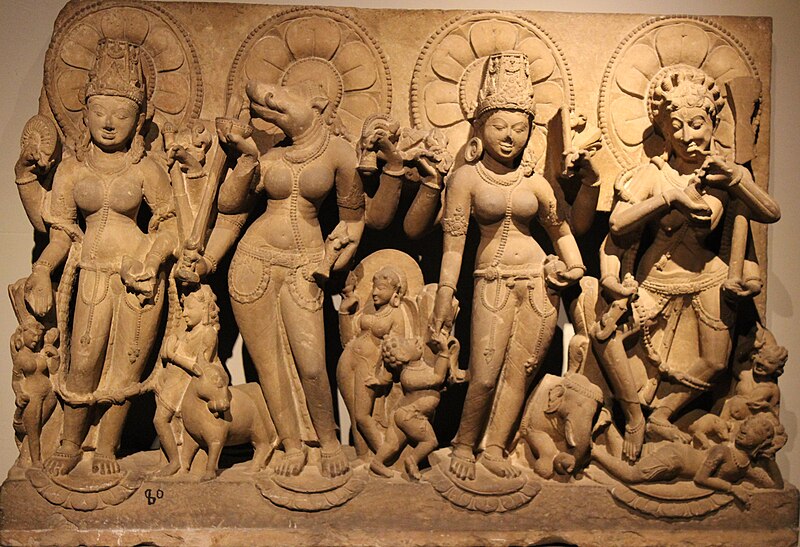
An exclusive puja dedicated to Devi Indrani is conducted during Ashada Navaratri. By conducting this puja, devotees get blessed with a healthy and prosperous life, and get rid of all the negative energies. Ashadh Navaratri usually falls between the months of June and July, according to the English calendar. This Navaratri is also known as gupt ( hidden ) Navaratri. It’s different from the other two Navaratris that are highly popular amongst Hindus and which are usually celebrated during March/April and September/ October. Ashadha Navaratri is devoted to nine forms of the Moher Goddess Shakti. It’s known for powerful tantric rituals and sadhanas. That’s why it’s called hidden navaratri because such rituals are usually done in secrecy.
Offerings for Devi Indrani
Devotion to Goddess Indrani is marked by a variety of rituals and practices that celebrate her protective and nurturing aspects. Worshipers often engage in ceremonies that invoke her strength, seeking her blessings for protection against harm and for fertility. These practices vary regionally but commonly include offerings of flowers, food, and the chanting of mantras dedicated to her. Her favorite offerings are cooked rice mixed with curd, vermillion, milk-gruel, betels, areca nut slices, fruits., etc. Devotees perform the puja by lighting cow ghee lamps and offer red hibiscus flowers to Devi Indrani. They chant prayers and mantra using rudraksha or beads of red sandalwood. Family members and neighbors are given a simple bhog ( offering ) of Khichi ( an Indian dish made of lentils and rice ) after the puja.
Indrrani Homam – A special havan ( fire-worship ) ceremony is also performed to please Devi Indrani. During this fire-worship ceremony, Vedic mantras dedicated to Devi Indrani are chanted to invoke the Goddess by making various offerings such as ghee and havan saamgaree ( a concoction of various herbs specially prepared as an offering to the fire ) to the sacred fire.
It is believed that by observing an Indrani Homam, devotees can get rid of all their doshas ( negative qualities ) and lead a life of prosperity, fulfillment, and peace. It’s also an effective puja for warding off evil spirits.
The Significance of Devi Indrani in Spiritual Protection
Indrani’s worship is especially significant for those seeking spiritual protection and strength. Her devotees believe that her blessings can shield them from negative forces and provide the fortitude needed to face life’s challenges. This aspect of her worship underscores the belief in the power of divine intervention and the importance of maintaining a spiritual connection with the divine for protection and guidance.
Devi Indrani’s Manifestations and Forms
Goddess Indrani is revered in many forms, each reflecting a different aspect of her divine nature. From the warrior goddess who battles demons to the nurturing mother who oversees fertility and well-being, her manifestations encompass the breadth of her powers and responsibilities. These diverse forms allow devotees to connect with Indrani in a manner that resonates with their personal spiritual needs and aspirations, highlighting the multifaceted nature of the divine.
Temples and Sacred Sites Dedicated to Devi Indrani
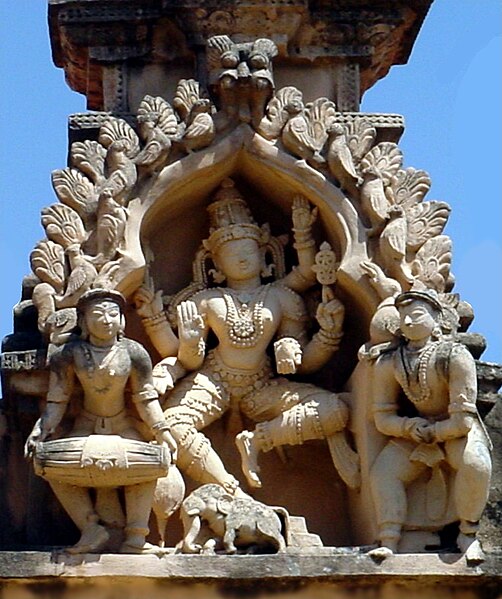
Indrani Devi is mostly worshipped as a form of Shakti or along with her husband Lord Indra. Therefore, temples exclusively dedicated to Goddess Indrani are rare.
However, there is a temple known as Shree Indrani Maa Temple located in the Indroda village of the city of Gandhinagar in Gujarat. Regarded by the locals as an ancient temple, this temple is said to have been renovated a couple of years back. According to various online reviews of this temple by local visitors, it is one of the very few temples dedicated to Devi Indirani in India. Also, the name of the village Indroda, where the temple is situated, derives its name from Devi Indrani, as per locals.
There are many ancient temples in India featuring sculptures and engravings depicting Lord Indra and Devi Indrani in various modes. Shri Madhukkeshwara temple Banavasi in the Indian state of Karnataka is an ancient Hindi dedicated to Lord Shiva. The temple dates back to the 9th century. Although Lord Shiva is the main deity of this temple, it’s a treasure trove of Vedic history as one can find sculptures and engravings of many other Vedic Gods and Goddesses. Devi Indrani and Lord Indra are also depicted in this temple seated on their vahana airavata elephant.
Contemporary art
Devi Indrani is depicted widely in various folk art forms of India. Many contemporary artists also create paintings portraying Devi Indrani. In contemporary representations, Goddess Indrani is mostly portrayed as a woman of ethereal beauty. She is adorned in a red saree, wearing elaborate jewels and mukut ( headgear made of various jewels ). In some representations, she is shown along with her vahana airavata elephant, while in others she is shown by herself.
Contemporary artistic representations of Goddess Indrani add a dimension of imaginative retelling and enrich her legends with their own perspective. Overall, we can say that contemporary artistic depictions of the Goddess take a great deal of creative liberty.
Symbols and Icons of Goddess Indrani
The symbols and colors associated with Goddess Indrani are rich with meaning, reflecting her attributes and powers. Red, often used in her worship, symbolizes strength and protection, while the elephant, her vahana, signifies dignity and wisdom. The vajra, or thunderbolt, represents her martial prowess and her role as a protector. These symbols are integral to her worship, serving as reminders of her divine qualities and the protection she offers to her devotees.
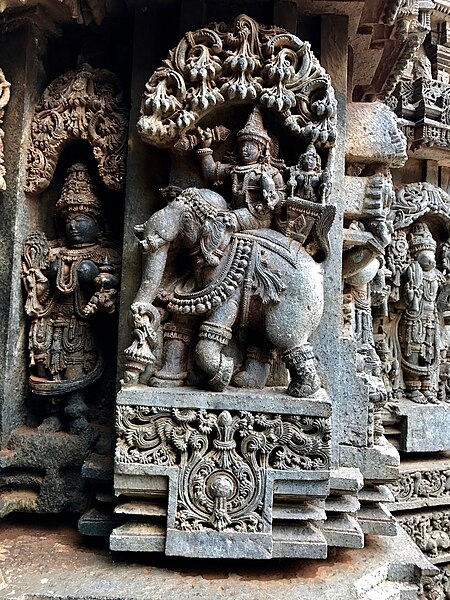
Reflection and Closing Thoughts
The myths and worship of Goddess Indrani offer valuable lessons on strength, protection, and the nurturing aspects of the divine. Her stories encourage devotees to seek divine guidance and protection in their lives. Emphasizing the importance of strength, courage, and devotion. The values embodied by Devi Indrani—protection, fertility, and strength—resonate across cultures. Together they are offering insights into the universal aspects of the divine feminine.
Devi Indrani is a somewhat unconventional Goddess. Being the daughter of asura Puloman, she comes from a clan of demons and is often referred to as the Goddess of Anger and jealousy. However, through various texts of Hinduism including the Vedas and the Puranas, we come to know about her divine attributes. Despite being from a family of asuras, she becomes the queen of Gods by marrying Lord Indra, the King of Gods. Goddess Indrani often comes to the rescue of Lord Indra when he gets into tricky circumstances and rescues him using her attributes of sharp intellect, intuition, and foresight.
Devi Indrani however is not without her flaws. She is often prone to jealousy, especially when it comes to liaisons of Lord Indra with other women. But she gets over those vikars ( flaws ) through severe austerity. Thus, she holds a mirror to the human soul. By worshipping Devi Indrani, we embark on a journey of self-introspection and move ahead on the path of getting rid of all our prejudices and negativity. She helps us cleanse our self step by step.
Embracing the Divine Feminine
The divine feminine is an integral part of Hinduism. In spiritual traditions of Hinduism, the masculine and feminine are two aspects of the universe that work in tandem. The masculine cannot exist and function without the feminine. Thus, divine consciousness is characterized by the constant interplay of masculine and feminine attributes.
Devi Indrani is the shadow of Lord Indra. According to one version of her story of creation, Lord Indra created his female self Indrani himself. She is also revered as an aspect of Shakti, the Supreme Mother Goddess of Hinduism. Thus, Devi Indrani in Hinduism embodies the essence of the feminine divine.
Understanding and embracing the role of Devi Indrani in Hindu mythology can deepen one’s spiritual connection. It might aslo increase your appreciation for the divine feminine. Her worship is a testament to the enduring power and relevance of the Goddess in contemporary spiritual practices. She is offering a pathway to divine protection, strength, and enlightenment. In reflecting on Devi Indrani’s virtues, devotees can find inspiration and guidance in their own spiritual journeys, fostering a deeper connection with the divine.
FAQs about Devi Indrani
Devi Indrani is the daughter of asura Puloman. Despite being born in a family of asuras, she became the consort of Lord Indra and the Queen of Gods. All because of her divine beauty, virtue, and purity.
Devi Indrani is often called the Goddess of Jealousy and Wrath. This means that by worshipping her, devotees can get rid of these negative attributes. Devi Indrani is also the Goddess of success, wealth, prosperity, peace, and fertility. By worshipping her, one can get rid of all doshas ( negative attributes ) blocking their progress in life.
Airavata elephant is the vahana of Goddess Indrani. She is often depicted seated on Airawat along with her husband Lord Indra.
Devi Indrani is also known by names such as Shachi, Mahendra, Aindri, Pulomaja, and Poulomi.
Devi Indrani finds a mention in religious literature of Jainism and one can find her representation in various Jain temples. In Jainism, she is described as the mirror image of Lord Indra. According to Jain beliefs, Lord Indra and Devi Indrani descended on earth to celebrate the birth of all the Tirthankars (supreme spiritual leaders of Jainism).
According to ancient Hindu texts, Devi Indrani is one of the Saptamatrikas, the seven divine mothers of Hinduism. She is often worshipped in south India along with the other Saptamatrikas.
Gallery
- 12th-century Vedic Indra and Indrani at Shaivism Hindu temple Hoysaleswara arts Halebidu Karnataka India
- Indra, Indrani, and Airavata in a 6th-century cave temple in Badami, Karnataka
- A painting of the Matrika Indrani, Nepal, c. 1800
- Goddess Indrani
- Indrani Goddess – Rock carved or metal carved sculptures in traditional Kalingan or Odia style.
- Indra Indrani and Airavat at hoysaleshwar temple
- Indra and Indrani (Museum of Asian Arts, Nice)
- 6th century Indra Indrani with elephant on Cave 3 ceiling, Badami Hindu cave temple Karnataka
Featured Image Credit: Los Angeles County Museum of Art, Public domain, via Wikimedia Commons


